Navigation
Install the app
How to install the app on iOS
Follow along with the video below to see how to install our site as a web app on your home screen.
Note: This feature may not be available in some browsers.
More options
You are using an out of date browser. It may not display this or other websites correctly.
You should upgrade or use an alternative browser.
You should upgrade or use an alternative browser.
The American Cemani Breeders Club...open forum
- Thread starter Steadfast
- Start date
Tiegrsi
Songster
Thanks Ms Biddy, for your pictures; and thank you Pyxis for the lesson, because I didn't know yoi could do that here. 
Ms Biddy, that's really interesting! I have no idea how common it is. The only pictures I've seen of the butchered bird was squid ink black meat...but they could have been artificially inhanced with food dye, actual squid ink, or photoshop!

Ms Biddy, that's really interesting! I have no idea how common it is. The only pictures I've seen of the butchered bird was squid ink black meat...but they could have been artificially inhanced with food dye, actual squid ink, or photoshop!
Tiegrsi
Songster
Well today my chicks were all pretty calm just after I put some fresh food down, so I decided to try to look inside their mouths.
Every. Tongue. Is. White.
I was hoping at least one or two would be at least GREY. Nope.
I read quite a bit about breeding and most people say to cull birds with white tongues, so...I guess they will remain yard candy, after all. I have some other babies hatching this weekend to sell next weekend, so I suppose we will pick our favorite 2 Cemani chicks to keep and sell the rest as culls.
Every. Tongue. Is. White.
I was hoping at least one or two would be at least GREY. Nope.

I read quite a bit about breeding and most people say to cull birds with white tongues, so...I guess they will remain yard candy, after all. I have some other babies hatching this weekend to sell next weekend, so I suppose we will pick our favorite 2 Cemani chicks to keep and sell the rest as culls.
If you truly love the breed and wish to produce quality and aren't afraid of putting in the time and effort needed to reflect that, then don't rush into culling quite so quick...
Yes, they're ideally supposed to be black through and through, but ask any Heritage breed breeder how many birds they actually have that meet every single criteria listed in their SOP... that number will be severely low to nil...
Perfect birds *do not* exist, thus why illustrations are always used in the SOP books for every representation of each breed... we strive for that perfect bird and in that journey we will produce better and better specimens each and every generation... that's what matters...
Another example... Silkies... no, not related to AC's, but they do possess the same genetic characteristic of fibromelanism in the skin, meat, organs and bones... look at the hatchery Silkies as compared to a dedicated breeders birds... compare mulberry/single combs/red combs/red wattles/beardlessness/skimpy crests/smooth feathers to ones breeders sell... yes, even a breeder will get culls, but fewer than the lack of quality seen in hatchery stock... fibromelanism will vary depending on what goal each breeder sets for themselves, but having those goals and inching towards them is what sets a breeder apart from a propagator/hatchery... quality over quantity... moral and ethical boundaries over the almighty dollar... you decide which is most important to you...
Start from where you are with what you have... work with what you can get... breed the best and keep moving forward, in time you will be happy with the results and even better, you can look back and take well earned pride in what you have achieved... and that is priceless...
My own are not perfect, and far from it in fact... but they're leaps and bounds better than what I started with and in that I am proud and pleased in what I have accomplished so far... culls are sold off as fibro mixes and priced accordingly, or given away, or put into a layer flock... each generation I raise the bar for selecting my keepers... I may cull for tiny points others may not, but that's where my bar is currently... work with where your own bar is and as long as you can raise it even a tiny bit each generation, then you're doing well...
As for lines, personally I won't touch anything other than TMA or GFF... anyone that claims to have perfect birds or the best in the country doesn't give me a feeling of full disclosure... and after much research, connecting dots and digging into many of the "popular" lines I found entirely too many discrepancies and downright falsehoods... be wary of any who give guarantees beyond a general good start with healthy birds...
This is just a bit of my own personal experiences, take from it what you will... we do our best to support others and stay positive about this breed, but unfortunately there are some black marks in their history within the US... that will never go away...
But if you want support, it is here... honesty in evaluating, also here... if you don't want to hear an answer though, don't ask the question...
Yes, they're ideally supposed to be black through and through, but ask any Heritage breed breeder how many birds they actually have that meet every single criteria listed in their SOP... that number will be severely low to nil...
Perfect birds *do not* exist, thus why illustrations are always used in the SOP books for every representation of each breed... we strive for that perfect bird and in that journey we will produce better and better specimens each and every generation... that's what matters...
Another example... Silkies... no, not related to AC's, but they do possess the same genetic characteristic of fibromelanism in the skin, meat, organs and bones... look at the hatchery Silkies as compared to a dedicated breeders birds... compare mulberry/single combs/red combs/red wattles/beardlessness/skimpy crests/smooth feathers to ones breeders sell... yes, even a breeder will get culls, but fewer than the lack of quality seen in hatchery stock... fibromelanism will vary depending on what goal each breeder sets for themselves, but having those goals and inching towards them is what sets a breeder apart from a propagator/hatchery... quality over quantity... moral and ethical boundaries over the almighty dollar... you decide which is most important to you...
Start from where you are with what you have... work with what you can get... breed the best and keep moving forward, in time you will be happy with the results and even better, you can look back and take well earned pride in what you have achieved... and that is priceless...
My own are not perfect, and far from it in fact... but they're leaps and bounds better than what I started with and in that I am proud and pleased in what I have accomplished so far... culls are sold off as fibro mixes and priced accordingly, or given away, or put into a layer flock... each generation I raise the bar for selecting my keepers... I may cull for tiny points others may not, but that's where my bar is currently... work with where your own bar is and as long as you can raise it even a tiny bit each generation, then you're doing well...

As for lines, personally I won't touch anything other than TMA or GFF... anyone that claims to have perfect birds or the best in the country doesn't give me a feeling of full disclosure... and after much research, connecting dots and digging into many of the "popular" lines I found entirely too many discrepancies and downright falsehoods... be wary of any who give guarantees beyond a general good start with healthy birds...
This is just a bit of my own personal experiences, take from it what you will... we do our best to support others and stay positive about this breed, but unfortunately there are some black marks in their history within the US... that will never go away...
But if you want support, it is here... honesty in evaluating, also here... if you don't want to hear an answer though, don't ask the question...

Thanks for sharing your perspective. We all must start somewhere is how I feel about it too. I'll be getting more chicks and will be able to hand pick the ones I want. White toenails and color leakage aren't so much of an issue but darker pigmentation and structure are things to keep an eye on.
Tiegrsi
Songster
Yes, they're ideally supposed to be black through and through, but...Perfect birds *do not* exist, ... we strive for that perfect bird and in that journey we will produce better and better specimens each and every generation... that's what matters...
That's good to know. Honestly I don't personally know much about breeding them...but then, I didn't know anything about breeding BCM until I purchased some of those and fell in love with the breed. It's good to know that it's possible to breed away from the lighter tongues and other issues.
For me, I don't think that is a good idea right now to put so much time and expense into breeding a bird that will have such a high cull rate. I think I will keep a trio of the darkest ones and sell the others as pet quality birds. BCM have a high enough cull rate as it is, but at least with those they get quite large pretty quickly and so are great for dinner. Perhaps in the future I will have more time and energy to devote to Cemanis (hence keeping a trio). Just in case, though, I will post some pictures tomorrow before I make my final decision.
As for lines, personally I won't touch anything other than TMA or GFF... anyone that claims to have perfect birds or the best in the country doesn't give me a feeling of full disclosure... and after much research, connecting dots and digging into many of the "popular" lines I found entirely too many discrepancies and downright falsehoods... be wary of any who give guarantees beyond a general good start with healthy birds...
I think that's true in all breeds...there are always "in" or popular breeders, and as much as I would love to BE one (lol), I can see the fault in coveting a particular line so much that you are willing to hedge your bets and get it from anyone who claims to possess birds from it. When I first got my Marans, the woman I bought them from showed me plenty of pictures that looked like good, healthy birds. I don't think she even bothered to tell me anything about what "line" they were from, and I didn't know to ask. After I got them and started seeing how beautiful they were becoming, I started doing research about the breed and saw several breeders mentioned in high standing. Little Peddler is held in high regard, but to be honest I don't love the way her birds look (not that they are unhealthy or anything, but that they are not quite the same "vision" that I have). She's done great things for egg color, though.
Tiegrsi
Songster
My apologies for the abundant pictures I'm about to post. I would LOVE to hear others' thoughts on which of these chicks appears the best to you and why, and if you can judge the sex of any of them by their combs at this point.
Also, When the chicks first arrived, they all appeared to be the same size. Within a week I had 4 that were clearly much larger than the others, and I assumed those were male. Now, there are only 3 that seem to be much larger than the others (1 fell behind I guess?), and of those 3, I think 1 might be female. Do Cemanis have specific growth rates for chicks male vs female?
The ones that had "clear" toes when I first posted have already darkened considerably. I also noticed that some of them have more grayish tongues and mouths than I originally thought.
Here goes:
First bird - Blue. Female, I think
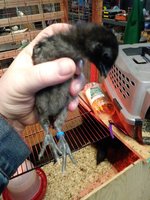
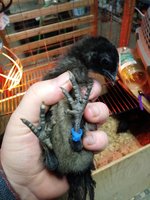
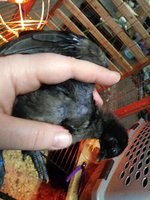
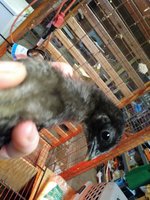
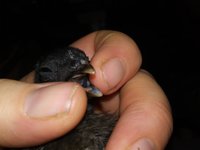
Second bird, Purple. Female?
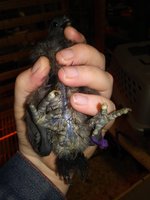
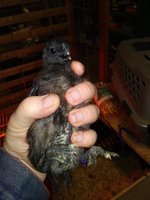
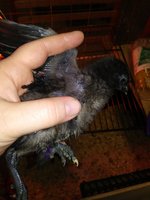
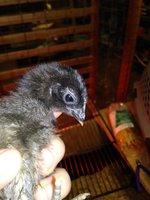
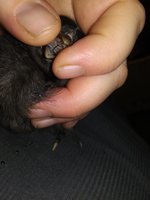
Yellow. Female
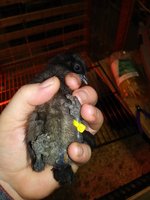
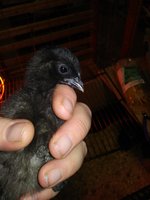
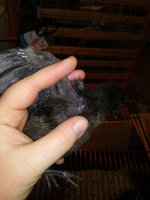
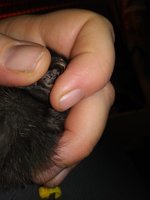
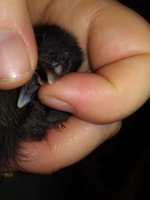
#4, Green. I THINK this one might be a boy with a slow developing comb.
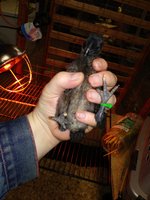
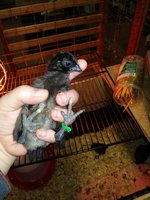
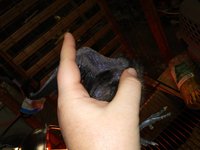
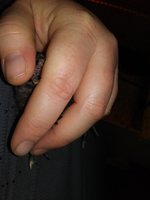
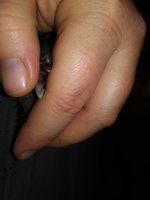
#5 Red. Male, for sure.
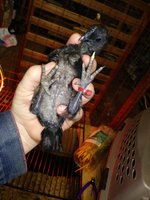
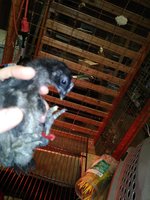
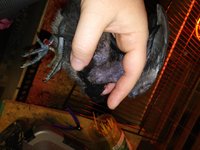
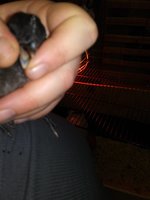
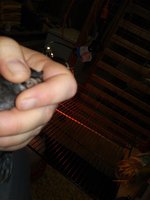
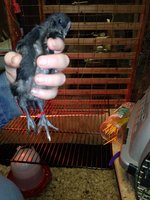
#6 White. Female?
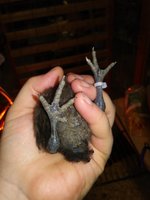
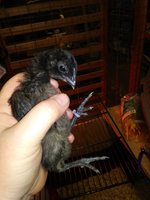
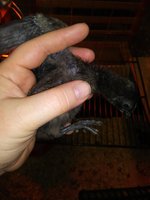
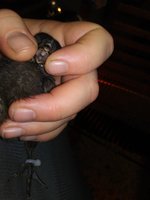
#7 White and Blue. Male. He has been missing feathers on his back since I received him. I think I read somewhere about some black genes being linked to a lack of feathers or poor quality feathers. Is that common in Cemani?
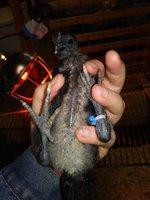
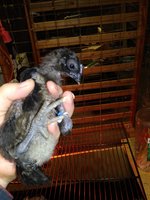
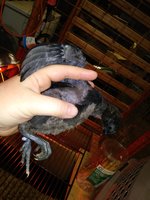
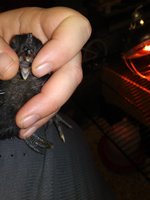
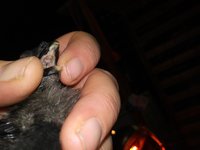
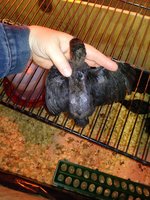
#8 Clear. I THINK female. This is the smallest of all the chicks.
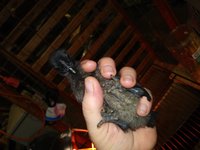
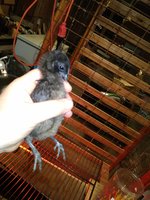
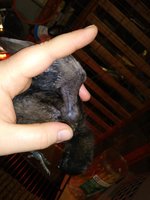
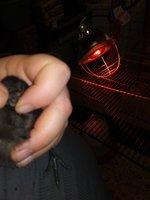
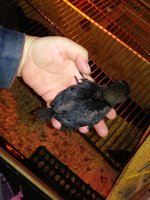
#9 ClearB. Pretty sure this one is male also - this one is the largest chick.
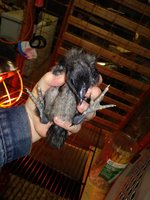
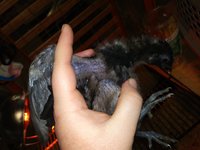
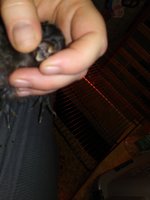
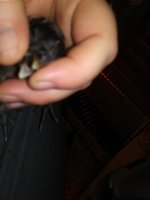
Also, When the chicks first arrived, they all appeared to be the same size. Within a week I had 4 that were clearly much larger than the others, and I assumed those were male. Now, there are only 3 that seem to be much larger than the others (1 fell behind I guess?), and of those 3, I think 1 might be female. Do Cemanis have specific growth rates for chicks male vs female?
The ones that had "clear" toes when I first posted have already darkened considerably. I also noticed that some of them have more grayish tongues and mouths than I originally thought.
Here goes:
First bird - Blue. Female, I think





Second bird, Purple. Female?





Yellow. Female





#4, Green. I THINK this one might be a boy with a slow developing comb.





#5 Red. Male, for sure.






#6 White. Female?




#7 White and Blue. Male. He has been missing feathers on his back since I received him. I think I read somewhere about some black genes being linked to a lack of feathers or poor quality feathers. Is that common in Cemani?






#8 Clear. I THINK female. This is the smallest of all the chicks.





#9 ClearB. Pretty sure this one is male also - this one is the largest chick.




New posts New threads Active threads
-
Latest threads
-
Duck can't walk or balance
- Started by MaxEstholt
- Replies: 0
-
-
-
-
-
-
Threads with more replies in the last 15 days
-
There is a time and place for shenanigans. (edit: THIS is that time and place)
- Started by azurbanclucker
- Replies: 452
-
Caged Bird and Parrot Thread!!!!
- Started by ShrekDawg
- Replies: 372
-
This is what a balanced layer feed with no treats delivers
- Started by Perris
- Replies: 122
-
-
Our first call duck incubation adventure (hatch-a-long)
- Started by MrsWinterWheat
- Replies: 90
-




